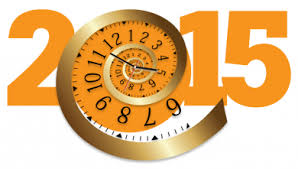
As always, compiling my best books of the year list is both a labor of love and a pain in the ass. On that one hand, I have to go through my entire year’s reviews at Reading Reality, The Book Pushers, Sci-Fi Romance Quarterly and Library Journal. I inevitably miss something, as I did when I put together my long list for the Best of 2015 Giveaway Hop and left out The Traitor Baru Cormorant by Seth Dickinson, which was thought-provokingly awesome.
It’s also a surprise to me that no romances ended up on the final list, although Secret Sisters by Jayne Ann Krentz and Shards of Hope by Nalini Singh made the longlist. There are two entries that have a touch of fantasy romance, but they felt much more like epic fantasy with a romantic subplot than purely romance.
How will mine stack up to yours? Read the entries and see for yourself.
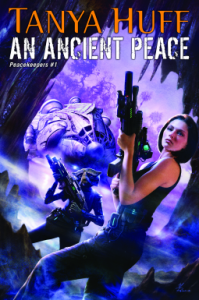 Based on this list, I enjoyed my trips to other worlds a lot this year. An Ancient Peace by Tanya Huff (reviewed here) is the lone pure SF title to make my list. I loved An Ancient Peace because it is epic space opera/military SF in a series I was so sorry to see end. And I’m so glad that it hasn’t.
Based on this list, I enjoyed my trips to other worlds a lot this year. An Ancient Peace by Tanya Huff (reviewed here) is the lone pure SF title to make my list. I loved An Ancient Peace because it is epic space opera/military SF in a series I was so sorry to see end. And I’m so glad that it hasn’t.
I also really liked Ancillary Mercy by Ann Leckie, but it wasn’t quite as good as the first two books in the series, Ancillary Justice and Ancillary Sword. Jean Johnson’s The Terrans should have made the list, but I finished the second book in the series, The V’Dan, a couple of days ago. And as my review at The Book Pushers elaborates, The V’Dan just didn’t stick the dismount. Awesome 9/10ths of a book, and the last 1/10th fell a little short.
Four titles on the list are epic fantasy in one way or another. Or at least they felt epic to me.
The Traitor Baru Cormorant by Seth Dickinson (reviewed at The Book Pushers) is an absolutely marvelous economic empire type fantasy. It is also a convoluted story about making bargains with the devil, paying the price, and finding out in the end that you have become the devil you intended to fight.
Both The Talon of the Hawk by Jeffe Kennedy and Uprooted by Naomi Novik are epic fantasies with a strong romantic subplot.
In The Talon of the Hawk (reviewed here) we see the epic conclusion to a journey of sisterhood. Three princesses become three strong queens who have to cut the shackles of their past to achieve a painful if necessary future. Talon is the story of the oldest princess and heir, and Ursula makes a strong, determined and absolutely fascinating warrior princess who has successfully put her emphasis on being a warrior, and can’t be bothered with the princess folderol – until she has to step up and be Queen.
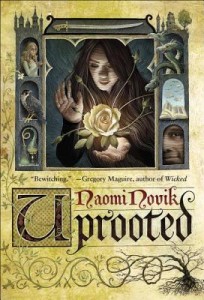 Uprooted by Naomi Novik (reviewed at The Book Pushers) is also a heroine’s journey, but in this case the heroine is a mage rather than a warrior, and she is also anything but a princess. And the story turns all the tropes about the village sacrificing the maiden to the dragon completely on their heads. It’s a terrific coming-of-age story and a marvelous tale where the battle between good and evil is not required to be invested in a big bad monster but still evokes plenty of evil.
Uprooted by Naomi Novik (reviewed at The Book Pushers) is also a heroine’s journey, but in this case the heroine is a mage rather than a warrior, and she is also anything but a princess. And the story turns all the tropes about the village sacrificing the maiden to the dragon completely on their heads. It’s a terrific coming-of-age story and a marvelous tale where the battle between good and evil is not required to be invested in a big bad monster but still evokes plenty of evil.
Sorcerer to the Crown by Zen Cho and The Shattered Court by M.J. Scott were the two “honorable mentions” in this category.
Two urban fantasies also made the list, Last First Snow by Max Gladstone and A Key, An Egg, An Unfortunate Remark by Harry Connolly.
Last First Snow (reviewed here) is the latest entry in Max Gladstone’s Craft Sequence. Even four books in, I still see this series as an urban fantasy set in an epic fantasy world. On the one hand, the underlying plot of this story is all about urban renewal (or urban removal) and the way that the projects always get spun and the original, generally poor, residents always get the shaft. But it’s also a story whose progress and conclusion are monitored by necromancer-lawyers, and whose protagonist is a failed priest who succeeds in the wrong place at the worst time.
A Key, An Egg, An Unfortunate Remark (reviewed here and on my Best E-Originals list at LJ) is pure urban fantasy, with a twist. The long and awkward title is a summary of the book, but the reader only figures that out as it unspools. What makes this book different and compelling is its heroine Marley Jacob. Marley is one of those traditional, strong, kick-ass, magic wielding urban fantasy heroines. Only 30 years later, and she is waging peace instead of war, which is much, much harder. Not so much “age and treachery beat youth and skill” as “age and experience beat youth and recklessness” but it works. The dragon in Puget Sound was a nice touch for this former Seattle resident.
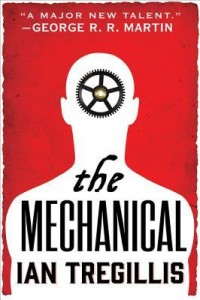 One final trip to another world made this list. The Mechanical by Ian Tregillis (reviewed here). In the author’s Alchemy Wars, the year is 1926, and the world has gone down a different path than the history we know. In the 17th century the Dutch scientist Christiaan Huygens discovered the method for creating mechanical servitors. The slave-race of “clakkers” has made life much easier for humans, but the slaves are more than just mechanical parts. They may not be biological, but they have free will and the desire to forge their own paths. How they will achieve their freedom is anyone’s guess, but it is bound to upset society as they know it. I’m in the middle of book two in this series, The Rising, as I write this. And so far, it’s equally as awesome as The Mechanical.
One final trip to another world made this list. The Mechanical by Ian Tregillis (reviewed here). In the author’s Alchemy Wars, the year is 1926, and the world has gone down a different path than the history we know. In the 17th century the Dutch scientist Christiaan Huygens discovered the method for creating mechanical servitors. The slave-race of “clakkers” has made life much easier for humans, but the slaves are more than just mechanical parts. They may not be biological, but they have free will and the desire to forge their own paths. How they will achieve their freedom is anyone’s guess, but it is bound to upset society as they know it. I’m in the middle of book two in this series, The Rising, as I write this. And so far, it’s equally as awesome as The Mechanical.
There’s a saying that “the past is another country, they do things differently there.” While I’ve discovered that I like historical romance less and less as time goes by, my love of history, historical fiction and historical mysteries continues unabated.
One piece of nonfiction made my list, and it’s specifically narrative nonfiction. In other words, even though the story is all true, the author spins it out in the best narrative fiction style. Erik Larsen’s Dead Wake reads like a compelling story, as well as a fascinating look at the end of a Golden age and the early years of World War I. Through diaries, letters and survivor interviews, Larsen makes the Lusitania sail again.
Speak Now by Kenji Yoshino, Freedom of Speech by David K. Shipler and The Interstellar Age by Jim Bell were “runners up” in nonfiction.
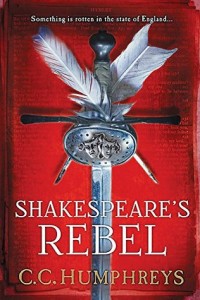 There were several historical fiction titles that made my final list. Shakespeare’s Rebel by CC Humphreys (reviewed here) is a gripping story of the later years of both William Shakespeare and Elizabeth I, as seen through the eyes of an actor who should never have been near the halls of power. John Lawley finds himself an unwelcome and sometimes unwitting observer as Shakespeare struggles to write Hamlet and Gloriana makes herself a fool for love one last time. It feels like you are standing amongst the groundlings at the Globe as this marvelous tale unfolds.
There were several historical fiction titles that made my final list. Shakespeare’s Rebel by CC Humphreys (reviewed here) is a gripping story of the later years of both William Shakespeare and Elizabeth I, as seen through the eyes of an actor who should never have been near the halls of power. John Lawley finds himself an unwelcome and sometimes unwitting observer as Shakespeare struggles to write Hamlet and Gloriana makes herself a fool for love one last time. It feels like you are standing amongst the groundlings at the Globe as this marvelous tale unfolds.
Two of my favorites this year were historical, but covered a much, much later period. A Touch of Stardust by Kate Alcott gives the reader an entrée into Hollywood’s Golden Age through the eyes of a young scriptwriter befriended by Carole Lombard. As our heroine watches Clark Gable and Vivien Leigh bring Gone With the Wind to glorious technicolor life, we also see her world as the stage darkens over the run up to World War II. A coming-of-age story wrapped in a love story surrounded by a war story.
And then there’s The Bookseller by Cynthia Swanson. In its early 1960s setting, we see the conditions that led up to the rise of feminism, but that isn’t the real story. The real story is of one woman who is living the road not taken every night when she dreams. But as she explores her two very different lives, she is forced to confront the less-than-idyllic situations that make up both of her possible presents – and she is forced to figure out which life is real, and which is merely an illusion. As I said in my review, this one really got me in the feels.
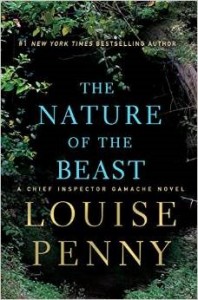 Although I also read a lot of mysteries this year, one stood out over all the rest. That was The Nature of the Beast by Louise Penny. As always, Louise Penny’s latest character study, with retired Surêté du Québec Chief Inspector Armand Gamache leading the investigation, was the best mystery I read all year, and one of the best books as well. Gamache’s four sayings that lead to wisdom resonate for me with every book, “I was wrong. I’m sorry. I don’t know. I need help.” In this case, I know I’m not wrong, and I know you won’t be sorry if you read this series. Start with Still Life. But the more of it you read and the more you know about the characters, the more fascinating it becomes.
Although I also read a lot of mysteries this year, one stood out over all the rest. That was The Nature of the Beast by Louise Penny. As always, Louise Penny’s latest character study, with retired Surêté du Québec Chief Inspector Armand Gamache leading the investigation, was the best mystery I read all year, and one of the best books as well. Gamache’s four sayings that lead to wisdom resonate for me with every book, “I was wrong. I’m sorry. I don’t know. I need help.” In this case, I know I’m not wrong, and I know you won’t be sorry if you read this series. Start with Still Life. But the more of it you read and the more you know about the characters, the more fascinating it becomes.
As is evidenced by this list, I enjoy historical fiction. I particularly love the place where historical fiction meets mystery in historical mysteries.
One of my best books this year is another latest entry in an ongoing series, A Pattern of Lies by Charles Todd, 7th in his Bess Crawford series. As World War I is finally beginning to wind down, this story finds nurse Bess Crawford visiting one of her former patients, only to discover that something is seriously wrong back home. Her duty as a nurse is all about patching up the wounds of war, but she uncovers a wound that she can’t patch. This is a story about the evil that men (and women) do in the name of justice. It’s also a story about just how easy it is to stoke mob violence, and how simple it is to turn blind prejudice into murder.
And for my two best books of the year. (Drumroll, please!)
These books aren’t much like each other, making it difficult to say that one is better, or more superlative, that then other. But I’ll try.
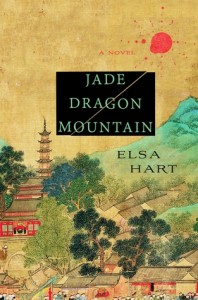 Jade Dragon Mountain by Elsa Hart (reviewed here) is a beautiful and evocative piece of historical fiction wrapped around the conundrum of a solving a murder. On a deadline and with very little support (and the detective’s possible own execution waiting at the end). Li Du is an exiled Imperial Librarian turned wandering scholar in early 18th century China. He stumbles over the death of a Jesuit priest, and refuses to let the local magistrate pronounce a lazy and face-saving verdict of death by natural causes. As Li Du pokes his curiosity into the dark corners of the regional palace administration, he finds a quiet rebellion that no one is willing to admit exists, and a plot to overthrow the Emperor that has been years in the making. He could walk away from saving the Emperor who exiled him. In the end he risks his own life in the service of the truth. And as Li Du winds his way through the court intrigue that he hoped to leave behind, we get a fantastic peek into a world that was closed to Westerners even at the time, and that peek is utterly absorbing.
Jade Dragon Mountain by Elsa Hart (reviewed here) is a beautiful and evocative piece of historical fiction wrapped around the conundrum of a solving a murder. On a deadline and with very little support (and the detective’s possible own execution waiting at the end). Li Du is an exiled Imperial Librarian turned wandering scholar in early 18th century China. He stumbles over the death of a Jesuit priest, and refuses to let the local magistrate pronounce a lazy and face-saving verdict of death by natural causes. As Li Du pokes his curiosity into the dark corners of the regional palace administration, he finds a quiet rebellion that no one is willing to admit exists, and a plot to overthrow the Emperor that has been years in the making. He could walk away from saving the Emperor who exiled him. In the end he risks his own life in the service of the truth. And as Li Du winds his way through the court intrigue that he hoped to leave behind, we get a fantastic peek into a world that was closed to Westerners even at the time, and that peek is utterly absorbing.
And I saved the very best (at least according to my reading) for last.
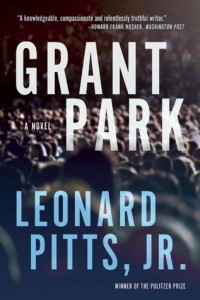 My favorite book of 2015 is Grant Park by Leonard Pitts, Jr. This is a story that fictionalizes and encapsulates two pivotal moments in 20th century American history, and views them through the eyes of two men whose lives were forever changed by those events. In 1968, Malcolm Toussaint and Ben Carson are young men marching for civil rights in the shadow of Martin Luther King, Jr. They are both there in Selma the moment when King was gunned down. And their lives were never the same. Forty years later, in 2008, they both work for one of the major Chicago newspapers on the eve of Barack Obama’s election. Toussaint is now a Pulitzer Prize winning columnist (not unlike the author) and Carson is his editor. Toussaint choses to throw his career away by publishing one angry column about his exhaustion at White America. He is utterly certain that in spite of the polls, Obama will not be elected. In the column, he pulls no punches, he pretends no remorse. He’s tired of being lied to. Unfortunately for Carson, Toussaint needs one last lie to get the column published – he uses Carson’s credentials to login to the system and approve the column to go to press. In the aftermath, both men lose their jobs. Then a couple of white supremacists kidnap Toussaint to use as a symbol in their terrorist act against the possibility of a black President. As Toussaint tries to save himself, Carson hunts him down in the hopes of getting a bit of payback at being collateral damage. But as the plot winds down, and the terrorists wind themselves up, both men reflect on that long ago afternoon, and how far we’ve come. And how far we haven’t.
My favorite book of 2015 is Grant Park by Leonard Pitts, Jr. This is a story that fictionalizes and encapsulates two pivotal moments in 20th century American history, and views them through the eyes of two men whose lives were forever changed by those events. In 1968, Malcolm Toussaint and Ben Carson are young men marching for civil rights in the shadow of Martin Luther King, Jr. They are both there in Selma the moment when King was gunned down. And their lives were never the same. Forty years later, in 2008, they both work for one of the major Chicago newspapers on the eve of Barack Obama’s election. Toussaint is now a Pulitzer Prize winning columnist (not unlike the author) and Carson is his editor. Toussaint choses to throw his career away by publishing one angry column about his exhaustion at White America. He is utterly certain that in spite of the polls, Obama will not be elected. In the column, he pulls no punches, he pretends no remorse. He’s tired of being lied to. Unfortunately for Carson, Toussaint needs one last lie to get the column published – he uses Carson’s credentials to login to the system and approve the column to go to press. In the aftermath, both men lose their jobs. Then a couple of white supremacists kidnap Toussaint to use as a symbol in their terrorist act against the possibility of a black President. As Toussaint tries to save himself, Carson hunts him down in the hopes of getting a bit of payback at being collateral damage. But as the plot winds down, and the terrorists wind themselves up, both men reflect on that long ago afternoon, and how far we’ve come. And how far we haven’t.
And that’s a wrap for this year. Next week, I’ll be taking a look at the books I’m most looking forward to in 2016. In the meantime, here’s the covers for all the books mentioned in this list:


































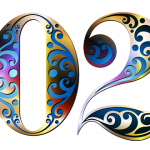
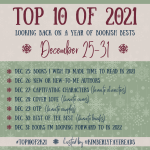

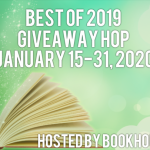
This is a great selection of books. I have several of these on my TBR list. Can’t wait to read them this new year. Thanks for sharing! Happy New Year!